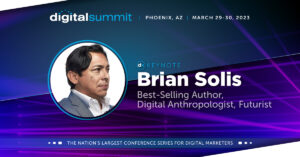
Part 2 in a media tour series for my 2016 keynote at Digital Business World Congress (DES) in Madrid, Spain. This interview is with Expansión, “La tecnología está creando una sociedad narcisista.”

Technology is creating a narcissistic society
We all talk a lot about change, but how can we change ourselves?
This question refers to a famous quote by Russian novelist Leo Tolstoy, “We all talk of change but we don’t talk of changing ourselves.” To change ourselves requires us to first accept that there is an opportunity for us to improve or alter something in how we see or do something today. In my research over the years, change, and innovation, begin with a shift in perspective. It takes the ability to see something that others can’t and then do the things that others won’t.
What does ‘egosystem’ refer to?
Customers today are becoming what I call “accidental narcissists.” Every app and service they use teaches them that they are the center of their own universe. Everything they share gives them immediate return, validation and fulfillment. The apps they love give them the services or things they want on-demad. The egosystem is a term I give to describe markets comprised of accidental narcissists. It’s important for brands to realize that these customers aren’t just waiting for them to say or sell something. They’re also not impressed with the archaic means in which companies communicate to them or force them to communicate with businesses. We need to put people first and one way to make the argument is to show that people are important…even self-important.
Can anybody be disruptive? Or are innovators made of a different cut?
Innovation is not something inherently in someone’s DNA. It’s something that takes new perspective and belief that their ideas or passions are the right thing to puruse. The more they are validated, the more they are supported and empowered, the more innovators can become innovators. When you compare that to risk averse cultures, where people are forced to operate in a mode of business as usual, the stage is set for disruption. The threat of disruption is measured by the amount you invest in innovation vs the amount you dissuade it.
It seems we are all becoming more introvert and that we get distracted more easily. Can a brand still communicate effectively with me?
I believe that technology is creating a sub-society of digital introverts. You would rather engage via the small screen than call someone or talk to someone face-to-face. But this is just part of the behaviorial shift happening with mobile, social and real-time technology. Attention spans have long withered away as a result of technology distractions and the poor attempts of marketers trying to earn relevance among a different breed of customer. To engage the egostem today takes a new understanding of what people value, how they discover, connect and share, and also their intentions and aspirations to develop a targeted and relentless approach to modern engagement.
If the customer’s experience is what defines a brand, is there a way brands can control their image?
Customer experience is defined by what customer’s feel as a result of the total sum of engagements with a company in every moment of truth throughout the lifecycle. Experience is the new brand and as such, companies need to invest in experience design. There’s a gap today between the brand promise and the experience people have and share. In a connected society, the experiences that people share online become the foundation for the brand. As people search, they are increasingly looking for what other’s have experienced. As I write in my new book X: The Experience When Business Meets Design, customer experience must be defined at the very top and brought to life in every aspect of customer engagement. That starts with defining what it is the customer should experience, what they should feel and do and in turn share in each touch point and more so, everything should add up to the desired brand.
What is digital Darwinism?
Digital Darwinism is the evolution of technology and its impact on society. It is changing behaviors, expectations, preferences and values of consumers (and employees). The challenge is to what extent companies compete for connected customers and employees.
Part 1 – Stop Talking About a Customer-Centered Culture and Build It Already (Más Movilidad)
Part 2 – Is Technology Creating a Narcissistic Society? (Expansión)
Part 3 – Digital Transformation Through a Global Lens (i9 Magazine)
About Brian
Brian Solis is principal analyst and futurist at Altimeter, the digital analyst group at Prophet, Brian is world renowned keynote speaker and 7x best-selling author. His latest book, X: Where Business Meets Design, explores the future of brand and customer engagement through experience design. Invite him to speak at your event or bring him in to inspire and change executive mindsets.
Connect with Brian!
Twitter: @briansolis
Facebook: TheBrianSolis
LinkedIn: BrianSolis
Instagram: BrianSolis
Youtube: BrianSolisTV
Snapchat: BrianSolis





Interesting question, Brian. I think the source of the problem lies in the creators, not the creation. Technology isn’t creating narcissistic people; instead, narcissistic people are creating technology that reflects their values. And we’ve done a great job!